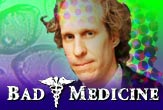The Appendix: Slimy But Not Worthless

Baltimore Orioles rookie Hayden Penn may go down in the record books as the first pitcher to miss his season debut because of appendicitis. Penn was to start in a game last week but was rushed to the hospital instead for emergency surgery.
While some baseball injuries seem inevitable—like home run king Barry Bonds getting an infected needle prick, or 250-pounder Runelvys Hernandez choking on a doughnut—this one came out of left field. But such is usually the case for appendicitis, an inflammation of the appendix, which most commonly strikes healthy young people between ages 10 and 30 without warning.
The 21-year-old Penn should be back in a couple of weeks. He had his appendix removed because, as we all know, the appendix serves no purpose ... right?
Wrong. Although most biology textbooks say the appendix is useless, we shouldn't sell the organ short.
Slimy but useful
Biologists in the early 20th century surmised that the human body had over 100 useless parts left over from our more ape-like lifestyle a few million years ago. The parathyroid was one such organ, now known to regulate calcium-phosphorous metabolism. The appendix was another.
The appendix is a slimy, dead-end sac that hangs between the small and large intestines. It's about a half inch in diameter and three inches long. As quickly as 11 weeks after conception, the appendix starts making endocrine cells for the developing fetus. Endocrine cells secrete useful chemicals, such as hormones, and the appendix endocrine cells secrete amines and peptide hormones that help with biological checks and balances as the fetus grows.
Get the world’s most fascinating discoveries delivered straight to your inbox.
After birth, the appendix mainly helps the body stave off disease by serving as a lymphoid organ. Lymphoid organs, with their lymphoid tissue, make white blood cells and antibodies.
The appendix, by virtue of its lymphoid tissue, is part of a complicated chain that makes B lymphocytes (one variety of white blood cell) and a class of antibodies known as immunoglobulin A antibodies. The appendix also produces certain chemicals that help direct the white blood cells to the parts of the body where they are needed the most.
The dirty gut is a good training ground for young white blood cells. The appendix, with its sac routinely collecting and expelling foodstuffs, exposes the white blood cells to myriad bacteria, viruses and drugs passing through the gastrointestinal tract. This way, the white blood cells learn to fight potentially deadly bacteria, such as E.coli.
The appendix's contribution to the body's white blood cell and antibody production reaches its peak when you are about 20 or 30 years old, then production falls off sharply. By age 60, the appendix serves very little active purpose.
Rotten luck
The appendix can cause trouble when food gets stuck in there. The food rots, causing an infection that can be fatal, particularly if the appendix bursts. Once infected, the appendix needs to be removed. Life goes on; you'll likely never miss it.
In the not-too-distant past, zealous doctors would remove the appendix during other types of surgery---to get it "out of the way" just in case it would some day become infected. The philosophy was: The appendix is useless; I'm already elbow-deep into this person's gut; why don't I just snip the appendix now.
But no more.
Doctors now realize they can use the appendix for reconstructive surgery. In one type of bladder "replacement" surgery, doctors take part of the intestine to form a bladder and use the appendix tissue to recreate a sphincter muscle, which can contract and open the bladder when urinating. Similarly, the appendix is used as a substitute ureter, a tube that carries urine from the kidneys to the bladder.
A healthy appendix is as good as gold in the body. Then again, think how much Hayden Penn could get selling his appendix on eBay.
Christopher Wanjek is the author of the books “Bad Medicine” and “Food At Work.” Got a question about Bad Medicine? Email Wanjek. If it’s really bad, he just might answer it in a future column. Bad Medicine appears each Tuesday on LIveScience.
More Bad Medicine
- The Good, the Bad and the Ugly Sperm
- When a Rolling Stone Bounces
- Treating the Symptoms: What's Wrong with U.S. Health Care
- Vitamin Mania: The Truth about Antioxidants
- Zacarias Moussaoui: Wicked But Not Schizophrenic
- Suffocating Trends: Oxygen Bars and Drinks
- Few Clues to High IQs
- Licensed to Kill: Some Doctors are Real Naturals
- War on Bacteria is Wrongheaded
- Soda Sales Go Flat, Industry Fights Back
- Go Ahead, Drink Bacon Grease for Breakfast

Christopher Wanjek is a Live Science contributor and a health and science writer. He is the author of three science books: Spacefarers (2020), Food at Work (2005) and Bad Medicine (2003). His "Food at Work" book and project, concerning workers' health, safety and productivity, was commissioned by the U.N.'s International Labor Organization. For Live Science, Christopher covers public health, nutrition and biology, and he has written extensively for The Washington Post and Sky & Telescope among others, as well as for the NASA Goddard Space Flight Center, where he was a senior writer. Christopher holds a Master of Health degree from Harvard School of Public Health and a degree in journalism from Temple University.


